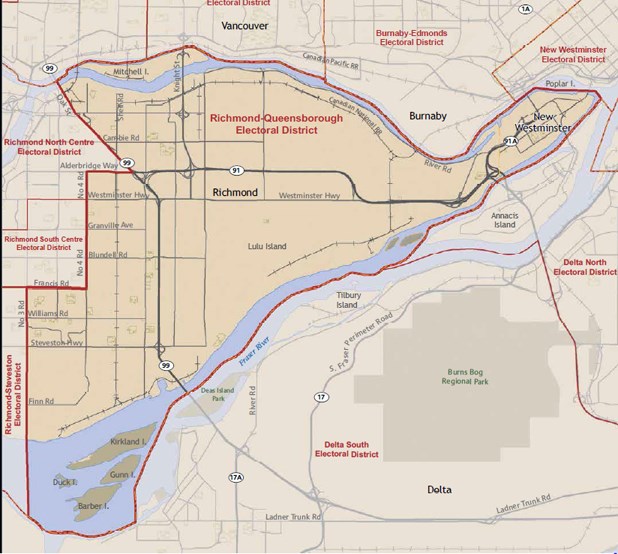Queensborough residents will be voting for their own MLA in the next provincial election – because of a few hundred folks.
B.C. Attorney General Suzanne Anton introduced legislation on Oct. 28 that would increase British Columbia’s electoral districts form 85 to 87 – with new ridings created in Richmond/New Westminster and Surrey to reflect the growing population in these areas.
“I’m heartbroken,” said New Westminster MLA Judy Darcy, who spoke about the proposal in the legislature. “I understand that the Electoral Boundaries Commission had a really difficult job. They are trying to balance urban and rural ridings. They set a maximum (population) limit for any riding. The average in the province is about 53,000 and they don’t want any deviation from it in excess of 25 per cent. That gets you to 66,000-and-something. And we have 67,000.”
The final report of the independent Electoral Boundaries Commission stated that two of Richmond’s current three electoral districts already exceed the allowable population for an electoral district and are projected to see significantly more growth. While Richmond’s population doesn’t warrant four electoral districts, the size of its electoral districts are above the provincial average – and so is New Westminster’s.
The Electoral Boundaries Commission proposed the creation of the new Richmond-Queensborough electoral district, which would combine Queensborough with the Hamilton neighbourhood of Richmond, most of East Richmond and a small part of the South Arm community.
“Queensborough gets lumped in with part of Richmond to create a new riding. We are just within a whisker of keeping them,” Darcy told the Record. “It will no doubt be passed this week.”
A number of Queensborough residents offered submissions to the Electoral Boundaries Commission, with most of them preferring to keep New Westminster all together. If the city needs to be divided, most said the Fraser River would be the most reasonable way to divide the riding.
“Queensborough residents attend religious services in New Westminster, send their children to New Westminster Secondary, conduct their shopping in the city and look forward to taking part in community celebrations and festivals within New Westminster,” said Queensborough resident Ronnie Nicolasora’s submission. “We identify New Westminster as our community and many of us rarely even enter the City of Richmond. When the federal Electoral Boundary Commission considered removing Queensborough from the rest of New Westminster in their review, the community uproar caused them to amend the proposed changes and keep the city together.”
The new Richmond-Queensborough riding would have an estimated population of 55,627, while the New Westminster riding would have 61,422.
“The commission had a very difficult job to do. They had to draw the line somewhere,” Darcy said. “I am just really, really sorry that we are going to lose Queensborough. I know so many people there. I know how much they identify with New Westminster. They will continue to identify with New Westminster because they are part of the city and part of the school district, but I will be very, very sorry to not continue to represent them.”



